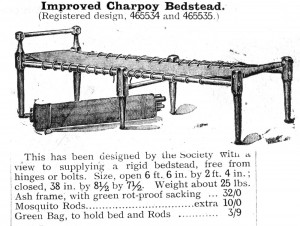We may receive a commission when you use our affiliate links. However, this does not impact our recommendations.
With my latest book, “Campaign Furniture,” I’m at the very titillating stage of processing several gigabytes of scanned images of furniture that I’ve gathered from musty British catalogs.
Many of these high-resolution images take several minutes to process, and so I abuse my friends with annoying text messages about Pepsi Max and acorns as Photoshop churns through the pixels.
Late last night as I was processing the 80th image, I put down my cell phone and squinted at the screen. The image was of a bedstead from a 1907 catalog, and dang didn’t those turnings look familiar?
The piece is called an “Improved Charpoy Bedstead.” “Charpoy” is a type of bed used in India and Pakistan that is basically ropes tied around a woven frame. (If you want to see more examples of the traditional form, search on the term “manjaa.” The bed looks shockingly like an ancient Egyptian bed, but that’s for another blog entry.)
The Charpoy Bedstead is built using Roorkee chair turnings and joinery. The two headboard pieces might be actual chair turnings. The bed was made by the Army & Navy Co-operative Society, which was basically a Sears catalog of goods for travelers and military families. I tried to look up the registered design numbers for the bed at the National Archives, but all I could suss from the “Brazil”-like interface is that the design was registered in 1905. Perhaps I need form 27B/6 to get more information.
I have yet to see one of these beds in the wild, but that’s no surprise. Though beds were one of the most common pieces of campaign furniture shown in catalogs and discussed in books, few of them survived the last 200 years for a variety of reasons.
As I have a stack of unused Roorkee legs sitting in my basement shop, perhaps I should build one of these beds for fun. Heck, with the amount of hours I’m spending on this book and ignoring my family, I might just need it.
— Christopher Schwarz
To read more about Roorkee chairs on the blog, click here. To purchase the October 2012 issue containing plans for the chair, visit ShopWoodworking here.
Here are some supplies and tools we find essential in our everyday work around the shop. We may receive a commission from sales referred by our links; however, we have carefully selected these products for their usefulness and quality.










That’s a familiar sight. I have laid on these beds and they are not comfortable.
A vast majority of village homes in India have them as their primary bed, sans the green rot-proof sacking of course. Usually they just have heavy jute rope intertwined across the posts and a blanket spread over the top of it. You also see them outside under trees during the hot season.
Are they native to India or did the British bring them over?
I like how when occupied all the nesting forces go toward making the joints tighter, but unoccupied it should come apart easily.
There is a very nice four poster campaign bed at Nunnington Hall in Yorkshire – it looks quite comfy although I doubt the elephants would thank you for it.